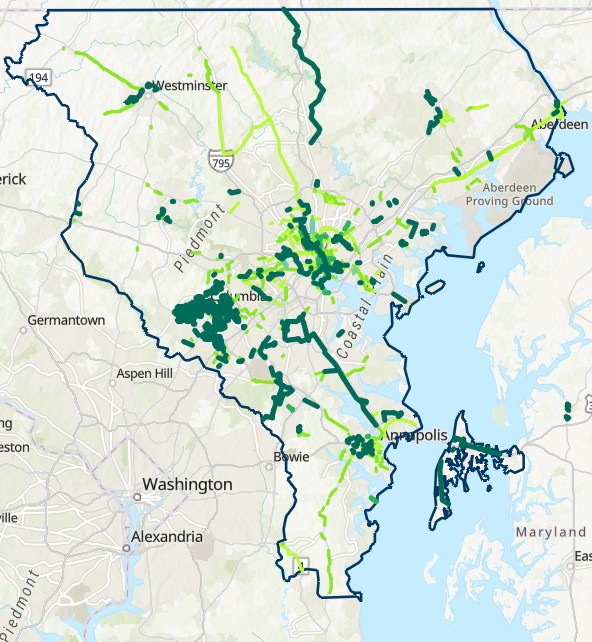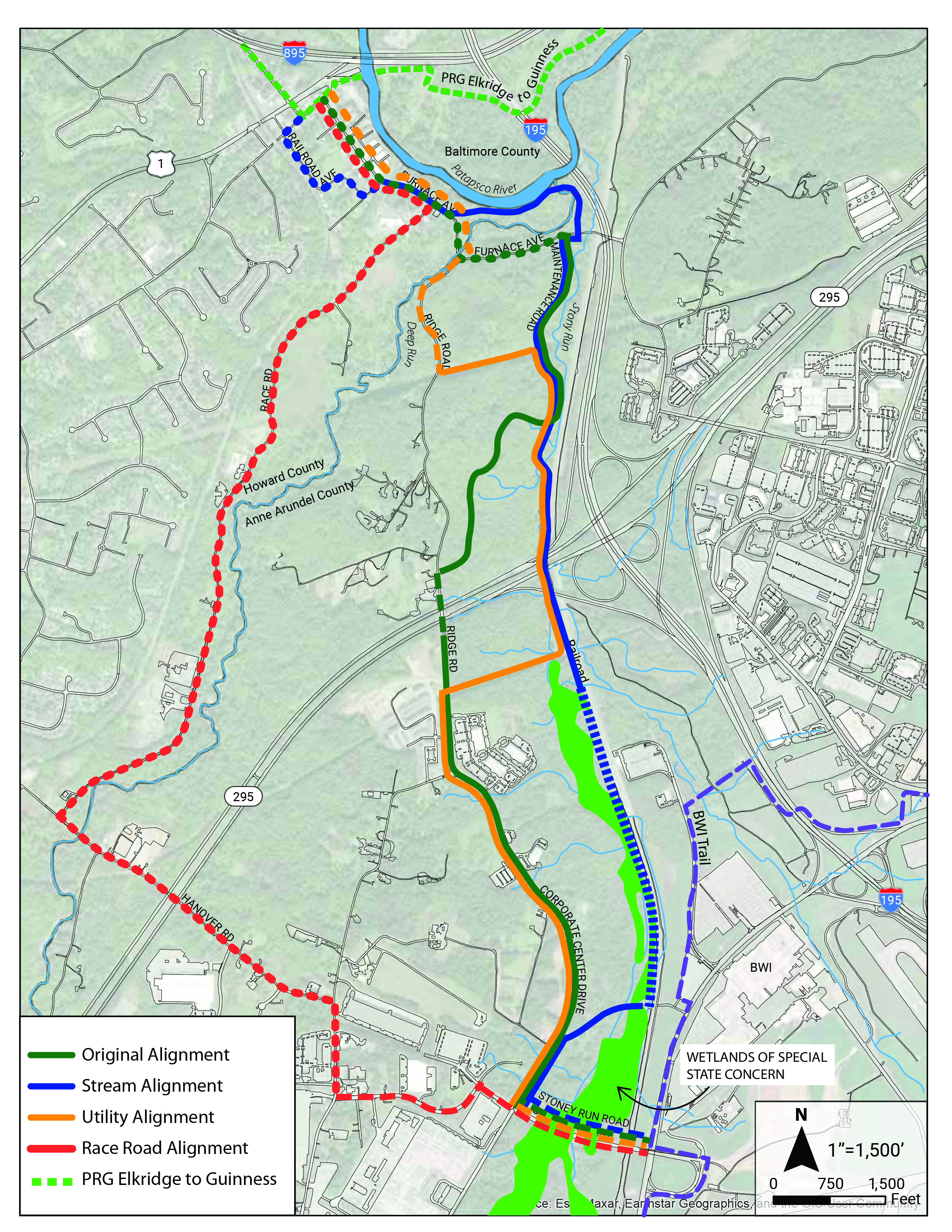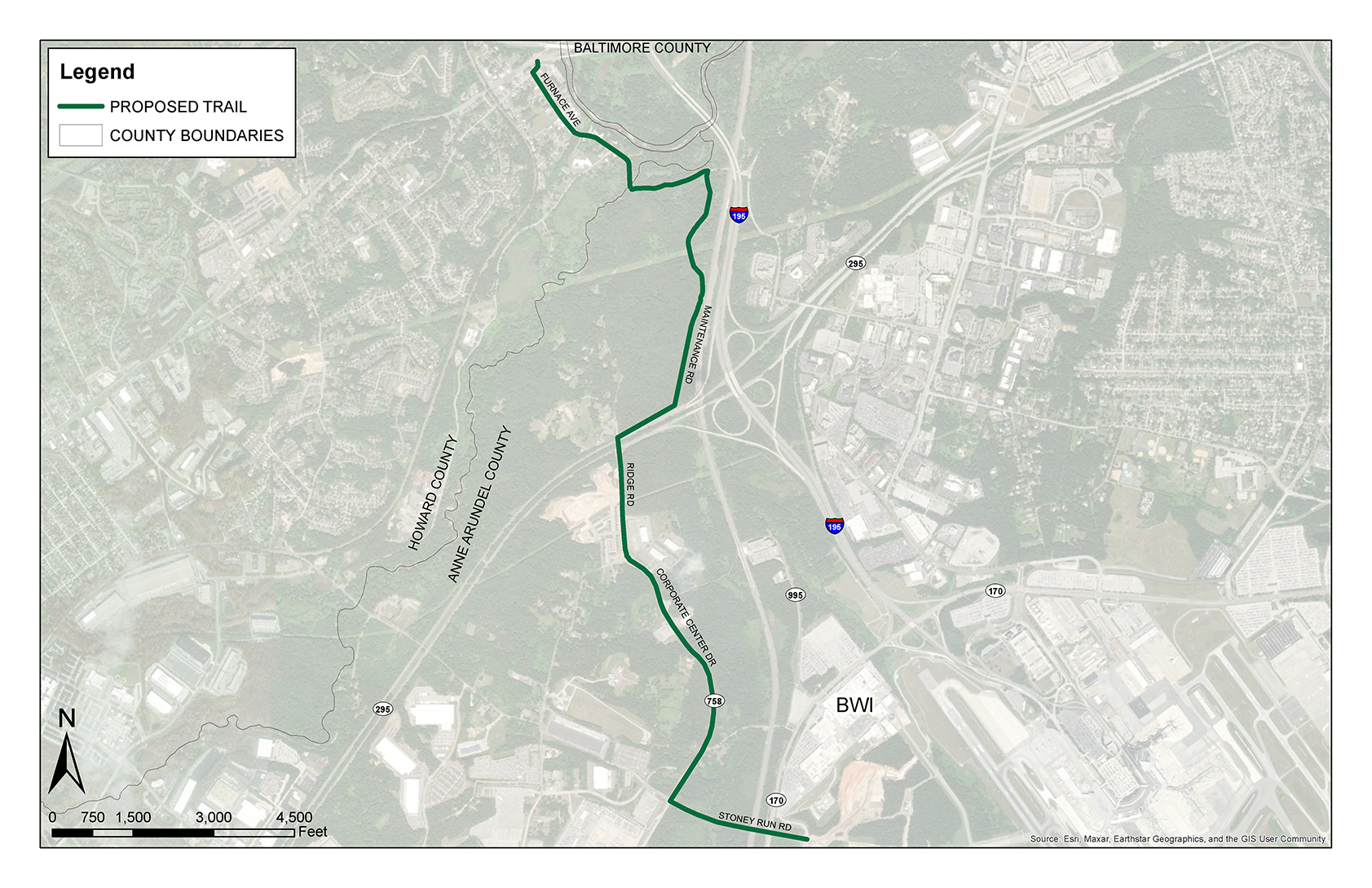
BALTIMORE, MD (Tuesday, May 21, 2024) –Baltimore Metropolitan Council (BMC) is working on a project, Bikeable Baltimore Region (BBR), that will identify the first regional bike network. A public comment period will be open from May 21 - July 26, 2024, and will include ten public meetings.
The BBR will identify a regional bike network of existing and planned bike facilities that are safe and comfortable for people of all ages and abilities. This bike network will benefit everyone by connecting our local communities and providing safe and equitable access to places people need to go, such as public transit, schools, work, and parks. This will be the first time a regionally connected bike network has been identified for the Baltimore region.

This comment period, also known as the listening phase, invites members of the public to share what they like and don’t like about biking in the Baltimore region, their thoughts on the project vision and goals, and what would make a regional bike network a success to them. There will be one more comment period later this year to get people’s feedback on the draft regional bike network and implementation strategy. The final report and interactive website will be released in the summer of 2025.
Learn more about the project and how to comment at publicinput.com/BikeBaltoRegion
Anyone wishing to discuss the project in more detail is welcome to join a public meeting at one of the following meetings between 6:00-7:30 PM: Monday, June 3, Harford County Community College; Thursday, June 6, North Laurel Community Center; Thursday, June 13, Odenton Public Library; Tuesday, June 18, Carroll County Public Library Exploration Commons; Thursday, June 20, Towson Public Library; Monday, June 24, Enoch Pratt Central Library; Tuesday, June 25, Pip Moyer Recreation Center; Thursday, June 27, Kent Island Public Library. Visit the project link for more information about parking availability and transit accessibility for each meeting. There will also be an opportunity to join two virtual meetings: 12:00 PM, Tuesday, June 4 and 6:00 PM, Wednesday, June 26. Anyone who cannot attend may view meeting materials at publicinput.com/BikeBaltoRegion.
Ways to comment include:
- Online at publicinput.com/BikeBaltoRegion
- Email BikeBaltoRegion@publicinput.com
- Text keyword ‘BikeBaltoRegion’ to 73224
- Call 855-925-2801 x 10292 toll-free and leave a voicemail
- Reach @BaltoMetroCo on social media with #BRTBListens
- Join any one of our ten public meetings linked here
###
Baltimore Metropolitan Council (BMC) works collaboratively with the chief elected officials in the region to create initiatives to improve quality of life and economic vitality. As the Baltimore region’s council of governments, BMC hosts the Baltimore Regional Transportation Board (BRTB) and supports local government by coordinating efforts in a range of policy areas including emergency preparedness, housing, cooperative purchasing, environmental planning and workforce development.
BMC operates its programs and services without regard to race, color or national origin in accordance with Title VI of the Civil Rights Act of 1964 and other applicable laws. BMC offers interpretation services, including language translation services and signage for the hearing impaired, at public meetings upon request with seven days advance notice. BMC will not exclude persons based on age, religion, or disability. For assistance, contact the Public Involvement Coordinator, comments@baltometro.org, or call 410-732-0500. Dial 7-1-1 or 800-735-2258 to initiate a TTY call through Maryland Relay. Usarios de Relay MD marquen 7-1-1. Si se necesita información de Título VI en español, llame al 410-732-0500.
BRTB publica un borrador del Transportation Improvement Program de 4.520 millones de dólares para 2025-2028
BALTIMORE, MD (jueves 16 de mayo de 2024) – La Junta de Transporte Regional de Baltimore (BRTB) está solicitando comentarios sobre un borrador del plan de inversión en transporte que anticipa $4,52 mil millones para proyectos en toda la región de Baltimore. El período de comentarios sobre el borrador finaliza el 17 de junio e incluye dos reuniones públicas virtuales el 10 de junio.
Conocido formalmente como Transportation Improvement Program (TIP), el plan incluye financiación para 162 proyectos de bicicletas, peatones, tránsito, puentes, carreteras y carga que los miembros de BRTB consideraron prioridades para la ventana de planificación 2025-2028.
Entre ellas se encuentran las mejoras de seguridad en docenas de intersecciones en la ciudad de Baltimore, reparaciones o reemplazos de puentes en los condados de Baltimore y Carroll, expansiones a lo largo de Snowden River Parkway en Columbia y desarrollo orientado al tránsito en Odenton y Aberdeen, así como la expansión del corredor de carga del túnel Howard Street de la Administración Portuaria de Maryland, los carriles de peaje expresos I-95 de la Autoridad de Transporte de Maryland desde White Marsh hasta Bel Air y la conexión de la Línea Roja de la Administración de Tránsito de Maryland a través de Baltimore.
"Impulsar la conectividad en todos los modos de viaje, mejorar los resultados ambientales y aumentar la seguridad para todos los usuarios son aspectos importantes de este TIP", dijo Todd Lang, Director de Planificación del Transporte del Consejo Metropolitano de Baltimore, la agencia que dota de personal y apoya a la BRTB. "Estos proyectos ayudarán a hacer avanzar la red de transporte de nuestra región".
El TIP 2025-2028 incluye alrededor de $2.3 mil millones para la preservación y expansión de carreteras, $1.28 mil millones para la preservación y expansión del tránsito y los trenes de cercanías, $463 millones para los puertos y $480 millones para reducciones de emisiones, mejoras de seguridad y otros gastos. El apoyo de agencias federales representa aproximadamente $2.8 mil millones de estos fondos, mientras que las agencias estatales y locales aportan $1.24 mil millones y los ingresos por peajes cubren $490 millones.
En particular, las inversiones en infraestructura para bicicletas y peatones provienen de muchas categorías, en particular la financiación para la preservación y expansión de carreteras. Este TIP también incluye fondos récord para el tránsito público en toda la región, lo que representa todos los proyectos de tránsito público solicitados por las agencias locales y estatales.
El borrador del TIP también incluye una Determinación de Conformidad de la Calidad del Aire, que evalúa que los proyectos en el TIP no retrasarán el progreso de la región de Baltimore hacia el cumplimiento de los estándares nacionales de calidad del aire.
Puede obtener más información sobre el borrador del TIP 2025-2028 y la Determinación de conformidad de la calidad del aire asociada a través de publicinput.com/BRTB-TIP.
La BRTB solicita al público que complete una breve encuesta sobre el borrador del TIP y agradece los comentarios abiertos sobre los proyectos o el proceso de planificación. La BRTB también organizará dos reuniones virtuales para que los participantes obtengan más información y hagan preguntas o comentarios. Ambas reuniones tendrán lugar el lunes 10 de junio, una a las 12 horas y uno a las 6:30.
Las formas de comentar incluyen:
- En línea a través de una breve encuesta en publicinput.com/BRTB-TIP
- Enviando un correo electrónico a BRTB-TIP@publicinput.com
- Enviar mensaje de texto con la palabra clave "BRTB-TIP" al 73224
- Dejar un mensaje de voz gratis al 855-925-2801x10279
- Llegando a @BaltoMetroCo en las redes sociales con #BRTBListens
- Unirse a una reunión pública virtual el lunes 10 de junio a las 12 p.m. o 6:30
###
El Consejo Metropolitano de Baltimore proporciona un foro regional para que los miembros, socios estatales y locales identifiquen intereses mutuos y colaboren en estrategias, planes y programas que ayuden a mejorar la vitalidad económica y la calidad de vida para todos.
BMC opera sus programas y servicios sin distinción de raza, color u origen nacional de acuerdo con el Título VI de la Ley de Derechos Civiles de 1964 y otras leyes aplicables. Se pueden brindar servicios apropiados a personas calificadas con discapacidades o aquellos que necesitan asistencia lingüística que presenten una solicitud al menos siete días antes de una reunión. Llame al 410-732-0500. Marque 7-1-1 o 800-735-2258 para iniciar una llamada TTY a través de Maryland Relay. Si necesita información del Título VI en español, llame al 410-732-0500.
Haga clic aquí para ver todas las noticias en español.


BALTIMORE, MD (Thursday, May 16, 2024) – The Baltimore Regional Transportation Board (BRTB) is seeking feedback on a draft transportation investment plan which anticipates $4.52 billion for projects throughout the Baltimore region. A comment period on the draft closes June 17, and includes two virtual public meetings on June 10.
Known formally as the Transportation Improvement Program (TIP), the plan includes funding for 162 bicycle, pedestrian, transit, bridge, highway and freight projects that BRTB members tapped as priorities for the 2025-2028 planning window.
Key among these are safety improvements at dozens of intersections in Baltimore City, bridge repairs or replacements in Baltimore and Carroll Counties, expansions along Snowden River Parkway in Columbia and transit-oriented development in Odenton and Aberdeen, as well as the Maryland Port Administration’s Howard Street Tunnel freight corridor expansion, the Maryland Transportation Authority’s I-95 Express Toll Lanes from White Marsh to Bel Air and the Maryland Transit Administration’s Red Line connection across Baltimore.
“Boosting connectivity across modes of travel, improving environmental outcomes and increasing safety for all users are important threads in this TIP,” said Todd Lang, Director of Transportation Planning at Baltimore Metropolitan Council, the agency that staffs and supports the BRTB. “These projects will help move our region’s transportation network forward.”
The 2025-2028 TIP includes about $2.3 billion for highway preservation and expansion, $1.28 billion for transit and commuter rail preservation and expansion, $463 million for the ports and $480 million for emissions reductions, safety improvements and other spending. Support from federal agencies accounts for about $2.8 billion of this funding, with state and local agencies providing $1.24 billion and toll revenues covering $490 million.
Notably, investments in bicycle and pedestrian infrastructure are drawn from many categories, particularly the funding for highway preservation and expansion. This TIP also includes record funding for transit throughout the region, accounting for all of the transit projects requested by local and state agencies.
The draft TIP also includes an Air Quality Conformity Determination, which assesses that the projects in the TIP will not delay the Baltimore region’s progress toward meeting national air quality standards.
You can learn more about the draft 2025-2028 TIP and associated Air Quality Conformity Determination via publicinput.com/BRTB-TIP.
The BRTB is asking members of the public to complete a brief survey on the draft TIP, and welcomes open-ended comments on the projects or planning process. The BRTB will also host two virtual meetings for participants to learn more and ask questions or make comments. Both meetings will take place on Monday, June 10, one at 12 p.m. and one at 6:30.
Ways to comment include:
- Online via a short survey at publicinput.com/BRTB-TIP
- Sending an email to BRTB-TIP@publicinput.com
- Texting keyword ‘BRTB-TIP’ to 73224
- Leaving a voicemail toll-free via 855-925-2801x10279
- Reaching @BaltoMetroCo on social media with #BRTBListens
- Joining a virtual public meeting on Monday, June 10 at 12 p.m. or 6:30
###
Baltimore Metropolitan Council (BMC) works collaboratively with the chief elected officials in the region to create initiatives to improve quality of life and economic vitality. As the Baltimore region’s council of governments, BMC hosts the Baltimore Regional Transportation Board (BRTB) and supports local government by coordinating efforts in a range of policy areas including emergency preparedness, housing, cooperative purchasing, environmental planning and workforce development.
BMC operates its programs and services without regard to race, color or national origin in accordance with Title VI of the Civil Rights Act of 1964 and other applicable laws. BMC offers interpretation services, including language translation services and signage for the hearing impaired, at public meetings upon request with seven days advance notice. BMC will not exclude persons based on age, religion, or disability. For assistance, contact the Public Involvement Coordinator, comments@baltometro.org, or call 410-732-0500. Dial 7-1-1 or 800-735-2258 to initiate a TTY call through Maryland Relay. Usarios de Relay MD marquen 7-1-1. Si se necesita información de Título VI en español, llame al 410-732-0500.
Opciones de senderos para revisión en el segmento Stoney Run de Patapsco Regional Greenway
BALTIMORE, MD (lunes 6 de mayo de 2024) – El Consejo Metropolitano de Baltimore (BMC) comparte cuatro opciones para un segmento de sendero de cuatro millas que conecta Elkridge Main Street con BWI Trail en Stoney Run Road. Un período de comentarios públicos sobre los planes se cerrará el 5 de junio de 2024 e incluirá una reunión en la sucursal Linthicum de la biblioteca pública del condado de Anne Arundel el 22 de mayo a las 6 p.m.
BMC compartió una encuesta inicial para recopilar comentarios del público sobre el sendero propuesto a principios de este año y encontró que el 97 por ciento de los encuestados apoyaban el proyecto. De los 100 encuestados, el 91 por ciento dijo que usaría el sendero para recreación o ejercicio, 39 anticipó usar el sendero para eventos como carreras de bicicletas, el 36 por ciento lo usaría para observar la vida silvestre y el 24 por ciento esperaba usar el sendero para viajar al trabajo o la escuela.
El sendero será parte de Patapsco Regional Greenway (PRG), un sendero de uso compartido previsto de 40 millas que conectará el puerto interior de Baltimore con Sykesville en el condado de Carroll a lo largo del valle de Patapsco. El sendero se conectará con otro segmento en desarrollo del PRG en Elkridge Main Street y se extenderá hacia el sur para conectarse con el sendero BWI existente, ampliando las conexiones disponibles para ciclistas, peatones, jinetes y otros usuarios.
BMC está colaborando con el condado de Anne Arundel, el condado de Howard y el Departamento de Recursos Naturales de Maryland para desarrollar planes para el sendero.
Después de compartir estos diseños más detallados para su revisión, el equipo del proyecto desarrollará una única "alineación preferida" basada en los comentarios del público y el análisis técnico. A finales de este año se compartirá un informe sobre la alineación preferida para revisión pública. Estos períodos de comentarios buscan garantizar que los comentarios de los miembros de las comunidades cercanas se consideren en cada etapa de la planificación.
Obtenga más información sobre el proyecto y cómo comentar en publicinput.com/prg.
Cualquiera que desee discutir el proyecto con más detalle puede unirse a una reunión pública en la sucursal Linthicum de la biblioteca pública del condado de Anne Arundel el miércoles 22 de mayo de 6 a 8 p.m. El aparcamiento está disponible en el sitio. La ubicación también es accesible al transporte público a través del tren ligero MTA en Linthicum. Cualquiera que no pueda asistir puede ver los materiales de la reunión a través de publicinput.com/prg.
Las formas de comentar incluyen:
- En línea en publicinput.com/prg
- Correo electrónico prgstoneyrun@publicinput.com
- Envíe la palabra clave "PRGStoneyRun" al 73224
- Llame gratis al 855-925-2801 x 1247 y deje un mensaje de voz
- Llegue a @BaltoMetroCo en las redes sociales con #BRTBListens
- Únase a nuestra reunión pública el miércoles 22 de mayo de 6 a 8 en la sucursal de Linthicum de la biblioteca pública del condado de Anne Arundel, 400 Shipley Road, Linthicum Heights, MD 21090

Un período de comentarios públicos sobre los planes se cerrará el 5 de junio de 2024 e incluirá una reunión en la sucursal Linthicum de la biblioteca pública del condado de Anne Arundel el 22 de mayo a las 6 p.m.
###
El Consejo Metropolitano de Baltimore proporciona un foro regional para que los miembros, socios estatales y locales identifiquen intereses mutuos y colaboren en estrategias, planes y programas que ayuden a mejorar la vitalidad económica y la calidad de vida para todos.
BMC opera sus programas y servicios sin distinción de raza, color u origen nacional de acuerdo con el Título VI de la Ley de Derechos Civiles de 1964 y otras leyes aplicables. Se pueden brindar servicios apropiados a personas calificadas con discapacidades o aquellos que necesitan asistencia lingüística que presenten una solicitud al menos siete días antes de una reunión. Llame al 410-732-0500. Marque 7-1-1 o 800-735-2258 para iniciar una llamada TTY a través de Maryland Relay. Si necesita información del Título VI en español, llame al 410-732-0500.


BALTIMORE, MD (Monday, May 6, 2024) – Baltimore Metropolitan Council (BMC) is sharing four options for a four mile trail segment connecting Elkridge Main Street to the BWI Trail at Stoney Run Road. A public comment period on the plans will close on June 5, 2024, and will include a meeting at the Anne Arundel County Public Library Linthicum Branch on May 22 at 6 p.m.
BMC shared an initial survey to gather public feedback on the proposed trail earlier this year, and found that 97 percent of respondents supported the project. Of the 100 respondents, 91 percent said they would use the trail for recreation or exercise, 39 anticipated using the trail for events such as bike races or running events, 36 percent would use it to see wildlife, and 24 percent expected to use the trail for traveling to work or school.
The trail will be part of the Patapsco Regional Greenway (PRG), an envisioned 40-mile shared-use trail connecting Baltimore’s Inner Harbor to Sykesville in Carroll County along the Patapsco Valley. The trail will connect with another developing segment of the PRG at Elkridge Main Street, and extend south to connect with the existing BWI Trail, expanding the connections available to bicyclists, pedestrians, equestrian riders and other users.
BMC is collaborating with Anne Arundel County, Howard County and the Maryland Department of Natural Resources to develop plans for the trail.
After sharing these more detailed designs for review, the project team will develop a single ‘preferred alignment’ based on public feedback and technical analysis. A report on the preferred alignment will be shared for public review later this year. These comment periods seek to ensure that feedback from members of nearby communities is considered at every stage of planning.
Learn more about the project and how to comment at publicinput.com/prg.
Anyone wishing to discuss the project in more detail is welcome to join a public meeting at the Anne Arundel County Public Library Linthicum Branch on Wednesday, May 22 from 6 to 8 p.m. Parking is available on site. The location is also transit accessible via the MTA Light Rail at Linthicum. Anyone who cannot attend may view meeting materials via publicinput.com/prg.

Ways to comment include:
- Online at publicinput.com/prg
- Email prgstoneyrun@publicinput.com
- Text keyword ‘PRGStoneyRun’ to 73224
- Call 855-925-2801 x 1247 toll-free and leave a voicemail
- Reach @BaltoMetroCo on social media with #BRTBListens
- Join our public meeting Wednesday, May 22 from 6 to 8 at the Anne Arundel County Public Library Linthicum Branch, 400 Shipley Road, Linthicum Heights, MD 21090
###
Baltimore Metropolitan Council (BMC) works collaboratively with the chief elected officials in the region to create initiatives to improve quality of life and economic vitality. As the Baltimore region’s council of governments, BMC hosts the Baltimore Regional Transportation Board (BRTB) and supports local government by coordinating efforts in a range of policy areas including emergency preparedness, housing, cooperative purchasing, environmental planning and workforce development.
BMC operates its programs and services without regard to race, color or national origin in accordance with Title VI of the Civil Rights Act of 1964 and other applicable laws. BMC offers interpretation services, including language translation services and signage for the hearing impaired, at public meetings upon request with seven days advance notice. BMC will not exclude persons based on age, religion, or disability. For assistance, contact the Public Involvement Coordinator, comments@baltometro.org, or call 410-732-0500. Dial 7-1-1 or 800-735-2258 to initiate a TTY call through Maryland Relay. Usarios de Relay MD marquen 7-1-1. Si se necesita información de Título VI en español, llame al 410-732-0500.
BRTB busca comentarios sobre la planificación y la divulgación para la certificación federal
BALTIMORE, MD (jueves 4 de abril de 2024) – La Junta de Transporte Regional de Baltimore (BRTB) está trabajando con socios de la Administración Federal de Carreteras y la Administración Federal de Tránsito para obtener la certificación. La BRTB está pidiendo al público que realice una encuesta sobre la planificación y la divulgación recientes antes del 7 de mayo, y organizará una reunión pública híbrida el 1 de mayo.
El proceso de certificación federal se lleva a cabo cada cuatro años y busca garantizar que la BRTB siga las reglas federales de planificación y divulgación. Desde la certificación más reciente de la BRTB en 2020, más de 1750 personas han intervenido en planes y proyectos, ayudando a dar forma al futuro del sistema de transporte de la región. La BRTB continúa esforzándose por llegar a más personas en la región y traer más voces al proceso de planificación.
"Sus comentarios son de vital importancia para nuestro proceso de certificación federal", dice Todd Lang, Director de Planificación del Transporte del Consejo Metropolitano de Baltimore, la agencia que dota de personal y apoya a la BRTB. "Ya sea que haya participado o no en nuestro trabajo de planificación anterior, queremos saber cómo podemos comunicarnos mejor con usted, compartir la información que necesita y obtener sus comentarios".
La BRTB es la organización de planificación metropolitana designada a nivel federal para la región de Baltimore. Los miembros de su junta incluyen funcionarios electos locales, así como especialistas de agencias locales, estatales y federales que guían la planificación y la elaboración de presupuestos del transporte en la región de Baltimore, evaluando necesidades y tendencias, escuchando a las comunidades y promoviendo prioridades compartidas para el movimiento de personas y bienes con una centrarse en la seguridad, la equidad y la resiliencia.
Esta revisión de certificación se centrará en el plan de transporte de largo plazo Resiliencia 2050 de BRTB, aprobado en 2023 y el Plan de Participación Pública de BRTB, actualizado en 2022, así como en los Programas de Mejora del Transporte más recientes, que se actualizan anualmente y actúan como presupuestos para proyectos del transporte en toda la región.
La BRTB está pidiendo al público que complete una breve encuesta sobre estos esfuerzos de planificación y divulgación. La BRTB también organizará una reunión pública híbrida el miércoles 1 de mayo a las 6:30 p.m. En la reunión, el público tendrá la oportunidad de aprender más sobre el proceso de certificación de los reguladores federales y hacer preguntas o compartir comentarios. Los participantes pueden unirse virtualmente o en persona en la oficina de McHenry Row del Consejo Metropolitano de Baltimore.
Las formas de comentar incluyen:
- En línea a través de una breve encuesta en publicinput.com/BRTBcertification
- Enviando un correo electrónico a BRTBcertification@publicinput.com
- Enviar mensaje de texto con la palabra clave "BRTBcertification" al 73224
- Dejar un mensaje de voz gratis al 855-925-2801x1774
- Llegue a @BaltoMetroCo en las redes sociales con #BRTBListens
- Unirse a una reunión pública el miércoles 1 de mayo de 2024 a las 6:30 p. m.
- Virtual: regístrese para obtener el enlace a través de publicinput.com/BRTBcertification
- En persona: visite la oficina de McHenry Row del Consejo Metropolitano de Baltimore en 1500 Whetstone Way, Suite 300, Baltimore MD 21230 (estacionamiento gratuito para visitantes, tránsito accesible a través de MTA Local 71 y 94 o Charm City Circulator Banner Route)
###
El Consejo Metropolitano de Baltimore proporciona un foro regional para que los miembros, socios estatales y locales identifiquen intereses mutuos y colaboren en estrategias, planes y programas que ayuden a mejorar la vitalidad económica y la calidad de vida para todos.
BMC opera sus programas y servicios sin distinción de raza, color u origen nacional de acuerdo con el Título VI de la Ley de Derechos Civiles de 1964 y otras leyes aplicables. Se pueden brindar servicios apropiados a personas calificadas con discapacidades o aquellos que necesitan asistencia lingüística que presenten una solicitud al menos siete días antes de una reunión. Llame al 410-732-0500. Marque 7-1-1 o 800-735-2258 para iniciar una llamada TTY a través de Maryland Relay. Si necesita información del Título VI en español, llame al 410-732-0500.


BALTIMORE, MD (Thursday, April 4, 2024) – The Baltimore Regional Transportation Board (BRTB) is working with partners at the Federal Highway Administration and Federal Transit Administration to get certified. The BRTB is asking members of the public to take a survey of recent planning and outreach by May 7, and will host a hybrid public meeting on May 1.
The process of federal certification takes place every four years, and seeks to ensure that the BRTB follows federal rules for planning and outreach. Since the BRTB’s most recent certification in 2020, more than 1,750 people have weighed in on plans and projects, helping shape the future of the region’s transportation system. The BRTB continues striving to reach more people around the region and bring more voices into the planning process.
“Your feedback is critically important to our federal certification process,” says Todd Lang, Director of Transportation Planning at Baltimore Metropolitan Council, the agency that staffs and supports the BRTB. “Whether or not you’ve taken part in our past planning work, we want to know how we can better reach you, share the information you need and get your feedback.”
The BRTB is the federally designated metropolitan planning organization for the Baltimore region. Its board members include local elected officials as well as local, state and federal agency specialists who guide transportation planning and budgeting in the Baltimore region, evaluating needs and trends, listening to communities, and advancing shared priorities for the movement of people and goods with a focus on safety, equity and resilience.
This certification review will focus on the BRTB’s Resilience 2050 long-range transportation plan, approved in 2023 and the BRTB’s Public Participation Plan, updated in 2022, as well as the most recent Transportation Improvement Programs, which are refreshed annually and act as budgets for transportation projects throughout the region.
The BRTB is asking members of the public to complete a brief survey on these planning and outreach efforts. The BRTB will also host a hybrid public meeting on Wednesday, May 1 at 6:30 p.m. At the meeting, members of the public will have a chance to learn more about the process of certification from federal regulators and ask questions or share comments. Participants can join virtually, or in-person at the Baltimore Metropolitan Council’s McHenry Row office.
Ways to comment include:
- Online via a short survey at publicinput.com/BRTBcertification
- Sending an email to BRTBcertification@publicinput.com
- Texting keyword ‘BRTBcertification’ to 73224
- Leaving a voicemail toll-free via 855-925-2801x1774
- Reach @BaltoMetroCo on social media with #BRTBListens
- Joining a public meeting on Wednesday, May 1, 2024 at 6:30 p.m.
- Virtual: register for the link via publicinput.com/BRTBcertification
- In-person: visit the Baltimore Metropolitan Council’s McHenry Row office at 1500 Whetstone Way, Suite 300, Baltimore MD 21230 (free visitor parking, transit accessible via MTA Local 71 and 94 or the Charm City Circulator Banner Route)
###
Baltimore Metropolitan Council (BMC) works collaboratively with the chief elected officials in the region to create initiatives to improve quality of life and economic vitality. As the Baltimore region’s council of governments, BMC hosts the Baltimore Regional Transportation Board (BRTB) and supports local government by coordinating efforts in a range of policy areas including emergency preparedness, housing, cooperative purchasing, environmental planning and workforce development.
BMC operates its programs and services without regard to race, color or national origin in accordance with Title VI of the Civil Rights Act of 1964 and other applicable laws. BMC offers interpretation services, including language translation services and signage for the hearing impaired, at public meetings upon request with seven days advance notice. BMC will not exclude persons based on age, religion, or disability. For assistance, contact the Public Involvement Coordinator, comments@baltometro.org, or call 410-732-0500. Dial 7-1-1 or 800-735-2258 to initiate a TTY call through Maryland Relay. Usarios de Relay MD marquen 7-1-1. Si se necesita información de Título VI en español, llame al 410-732-0500.
BRTB comparte el borrador del presupuesto de planificación de transporte para el año fiscal 25 para comentario público
BALTIMORE, MD (miércoles 7 de febrero de 2024) – La Junta de Transporte Regional de Baltimore (BRTB) está redactando un presupuesto de planificación del transporte para el próximo año fiscal, proponiendo $10,6 millones para una variedad de estudios, planes y proyectos. El período de comentarios públicos sobre el proyecto de presupuesto cierra el 11 de marzo.
Con personal y apoyo del Consejo Metropolitano de Baltimore (BMC), la BRTB es la organización de planificación metropolitana de la región bajo mandato federal. La mayor parte de la financiación prevista para el próximo presupuesto, formalmente denominado Programa de Trabajo de Planificación Unificada, proviene de la Administración Federal de Carreteras y la Administración Federal de Tránsito, con contribuciones adicionales del Departamento de Transporte de Maryland y las jurisdicciones locales.
"A menudo solicitamos comentarios de los miembros de la comunidad sobre planes y proyectos específicos", dijo el Director de Transporte de BMC, Todd Lang. "Esta es una oportunidad para que el público opine sobre nuestro presupuesto general y el trabajo que nos gustaría realizar el próximo año".
La BRTB colaboró con planificadores en jurisdicciones locales y miembros de la comunidad para desarrollar el presupuesto propuesto basado en el trabajo en curso, las prioridades regionales y los comentarios de actividades de divulgación pública anteriores. Las partidas de financiación del proyecto de presupuesto para el año fiscal 2025 incluyen:
- Realizar una Evaluación de Necesidades de Transporte para identificar necesidades y desafíos para los usuarios del sistema de transporte de la región, con enfoque en las poblaciones vulnerables.
- Continuando con el programa de subvenciones Conexión de Transporte y Uso de la Tierra, que desbloquea rápidamente recursos para ayudar a las jurisdicciones locales a mejorar las instalaciones para ciclistas y peatones.
- Ampliar la campaña de divulgación sobre seguridad vial Look Alive para llegar a más personas que conducen, andan en bicicleta y caminan en la región a través de métodos más creativos y atractivos.
- Planificar un camino de uso compartido que conecte la estación de tren ligero Patapsco con el vecindario Cherry Hill de Baltimore, avanzando otra parte de la Vía Verde Regional Patapsco.
- Redactar el próximo plan de transporte de la región a corto plazo (con un horizonte de cinco años) y sentar las bases para el próximo plan de largo plazo (con un horizonte de veinte años).
Estas son sólo algunas de las partidas incluidas en el proyecto de presupuesto. Si la BRTB y los reguladores federales aprueban el presupuesto de planificación del transporte, el personal de planificación de BMC comenzará este trabajo cuando comience el año fiscal el 1 de julio. Las nuevas tareas propuestas se describen en detalle en el borrador del documento, que está disponible en línea en publicinput.com/BRTBbudget.
Los miembros del público pueden comentar sobre el borrador del presupuesto de planificación del transporte antes del lunes 11 de marzo. Después de colaborar con las jurisdicciones locales para revisar todos los comentarios y responder a las preguntas, la BRTB considerará la aprobación del presupuesto de planificación del transporte en una reunión el viernes 19 de abril. .
Las formas de comentar incluyen:
- En línea a través de una breve encuesta en publicinput.com/BRTBbudget
- Enviando un correo electrónico a FY25BRTBbudget@publicinput.com
- Enviar un mensaje de texto con la palabra clave "FY25BRTBbudget" al 73224
- Dejar un mensaje de voz gratis al 855-925-2801x6880
- Encontrarnos en Facebook, Instagram, X o LinkedIn (los comentarios en publicaciones de redes sociales se revisan, pero no se incluyen en el registro público oficial)
###
El Consejo Metropolitano de Baltimore proporciona un foro regional para que los miembros, socios estatales y locales identifiquen intereses mutuos y colaboren en estrategias, planes y programas que ayuden a mejorar la vitalidad económica y la calidad de vida para todos.
BMC opera sus programas y servicios sin distinción de raza, color u origen nacional de acuerdo con el Título VI de la Ley de Derechos Civiles de 1964 y otras leyes aplicables. Se pueden brindar servicios apropiados a personas calificadas con discapacidades o aquellos que necesitan asistencia lingüística que presenten una solicitud al menos siete días antes de una reunión. Llame al 410-732-0500. Marque 7-1-1 o 800-735-2258 para iniciar una llamada TTY a través de Maryland Relay. Si necesita información del Título VI en español, llame al 410-732-0500.


BALTIMORE, MD (Wednesday, February 7, 2024) – The Baltimore Regional Transportation Board (BRTB) is drafting a transportation planning budget for the upcoming fiscal year, proposing $10.6 million for a range of studies, plans and projects. A public comment period on the draft budget closes on March 11.
Staffed and supported by the Baltimore Metropolitan Council (BMC), the BRTB is the region’s federally mandated metropolitan planning organization. Most of the anticipated funding for the upcoming budget, formally titled the Unified Planning Work Program, comes from the Federal Highway Administration and Federal Transit Administration, with additional contributions from the Maryland Department of Transportation and local jurisdictions.
“We often ask for feedback from community members on specific plans and projects,” said BMC Director of Transportation Todd Lang. “This is a chance for the public to weigh in on our overall budget and the work we’d like to achieve in the next year.”
The BRTB collaborated with planners in local jurisdictions and community members to develop the proposed budget based on ongoing work, regional priorities and feedback from previous public outreach. Funding items in the proposed budget for fiscal year 2025 include:
- Conducting a Transportation Needs Assessment to identify needs and challenges for users of the region’s transportation system, with a focus on vulnerable populations,
- Continuing the Transportation and Land Use Connection grant program, which quickly unlocks resources to help local jurisdictions improve bicycle and pedestrian facilities,
- Expanding the Look Alive road safety outreach campaign to reach more people who drive, bike and walk in the region through more creative and engaging methods,
- Planning a shared-use path connecting the Patapsco Light Rail Station to Baltimore’s Cherry Hill neighborhood, advancing another piece of the Patapsco Regional Greenway,
- Drafting the region’s next short-range transportation plan (with a five-year horizon) and laying the groundwork for the next long-range plan (with a twenty-year horizon).
These are just some of the items included in the draft budget. If the BRTB and federal regulators approve the transportation planning budget, planning staff at BMC will start this work when the fiscal year begins on July 1. Proposed new tasks are described in detail in the draft document, which is available online via publicinput.com/BRTBbudget.
Members of the public can comment on the draft transportation planning budget by Monday, March 11. After collaborating with local jurisdictions to review all comments and respond to questions, the BRTB will consider approval of the transportation planning budget at a meeting on Friday, April 19.
Ways to comment include:
- Online via a short survey at publicinput.com/BRTBbudget
- Sending an email to FY25BRTBbudget@publicinput.com
- Texting keyword ‘FY25BRTBbudget’ to 73224
- Leaving a voicemail toll-free via 855-925-2801x6880
- Finding us on Facebook, Instagram, X or LinkedIn (comments on social media posts are reviewed, but are not included in the official public record)
###
Baltimore Metropolitan Council (BMC) works collaboratively with the chief elected officials in the region to create initiatives to improve quality of life and economic vitality. As the Baltimore region’s council of governments, BMC hosts the Baltimore Regional Transportation Board (BRTB) and supports local government by coordinating efforts in a range of policy areas including emergency preparedness, housing, cooperative purchasing, environmental planning and workforce development.
BMC operates its programs and services without regard to race, color or national origin in accordance with Title VI of the Civil Rights Act of 1964 and other applicable laws. Appropriate services can be provided to qualified individuals with disabilities or those in need of language assistance who submit a request at least seven days prior to a meeting. Call 410- 732-0500. Dial 7-1-1 or 800-735-2258 to initiate a TTY call through Maryland Relay. Si se necesita información de Título VI en español, llame al 410-732-0500.
BRTB comparte conceptos para el segmento del Patapsco Regional Greenway en Stoney Run
BALTIMORE, MD (miércoles 17 de enero de 2024) – El Consejo Metropolitano de Baltimore (BMC) está comenzando a planificar un sendero de cuatro millas que conectará Elkridge Main Street con BWI Trail en Stoney Run Road. Un período de comentarios públicos sobre los planes preliminares se cerrará el 16 de febrero de 2024 e incluirá una reunión en la sucursal de Elkridge de la biblioteca del condado de Howard el 6 de febrero a las 6 p.m.
El sendero será parte de Patapsco Regional Greenway (PRG), un sendero de uso compartido previsto de 40 millas que conectará el puerto interior de Baltimore con Sykesville en el condado de Carroll a lo largo del valle de Patapsco. El sendero se conectará con otro segmento en desarrollo del PRG en Elkridge Main Street y se extenderá hacia el sur para conectarse con el sendero BWI existente, ampliando las conexiones disponibles para ciclistas, peatones, jinetes y otros usuarios.
BMC está colaborando con el condado de Anne Arundel, el condado de Howard y el Departamento de Recursos Naturales de Maryland para desarrollar planes para el sendero.
Este período de comentarios inicial invita al público a opinar desde el principio sobre el concepto. Otro período de comentarios a finales de este año presentará rutas propuestas para revisión pública, y un tercer período de comentarios invitará al público a compartir comentarios adicionales sobre una única "alineación preferida" antes de que avance el diseño y la construcción. Estos períodos de comentarios buscan garantizar que podamos considerar sus comentarios en cada etapa de la planificación.
Obtenga más información sobre el proyecto y cómo comentar en publicinput.com/prg.

Un período de comentarios públicos sobre los planes preliminares se cerrará el 16 de febrero de 2024 e incluirá una reunión en la sucursal de Elkridge de la biblioteca del condado de Howard el 6 de febrero a las 6 p.m.
Cualquiera que desee discutir el proyecto con más detalle puede unirse a una reunión pública en la sucursal de Elkridge de la biblioteca del condado de Howard el miércoles 6 de febrero de 6 p.m. a 8:00 p.m. Aparcamiento en el sitio. Transporte público accesible a través de la ruta RTA 409 en Rowanberry Drive/Elkridge Library. Cualquiera que no pueda asistir puede ver los materiales de la reunión en publicinput.com/prg.
Las formas de comentar incluyen:
- En línea en publicinput.com/prg
- Correo electrónico prgstoneyrun@publicinput.com
- Envíe la palabra clave "PRGStoneyRun" al 73224
- Llame gratis al 855-925-2801 x 3937 y deje un mensaje de voz
- Llegue a @BaltoMetroCo en las redes sociales con #BRTBListens
- Únase a nuestra reunión pública el martes 6 de febrero de 6 p.m. a 8 p.m. en la sucursal de Elkridge de la biblioteca del condado de Howard, 6540 Washington Boulevard, Elkridge, MD 21075
###
El Consejo Metropolitano de Baltimore proporciona un foro regional para que los miembros, socios estatales y locales identifiquen intereses mutuos y colaboren en estrategias, planes y programas que ayuden a mejorar la vitalidad económica y la calidad de vida para todos.
BMC opera sus programas y servicios sin distinción de raza, color u origen nacional de acuerdo con el Título VI de la Ley de Derechos Civiles de 1964 y otras leyes aplicables. Se pueden brindar servicios apropiados a personas calificadas con discapacidades o aquellos que necesitan asistencia lingüística que presenten una solicitud al menos siete días antes de una reunión. Llame al 410-732-0500. Marque 7-1-1 o 800-735-2258 para iniciar una llamada TTY a través de Maryland Relay. Si necesita información del Título VI en español, llame al 410-732-0500.

